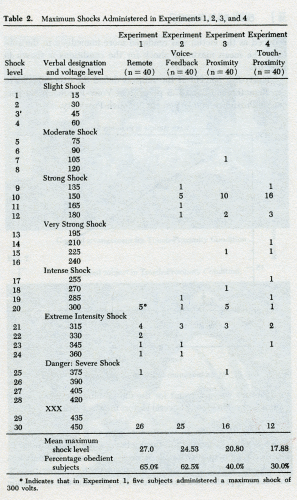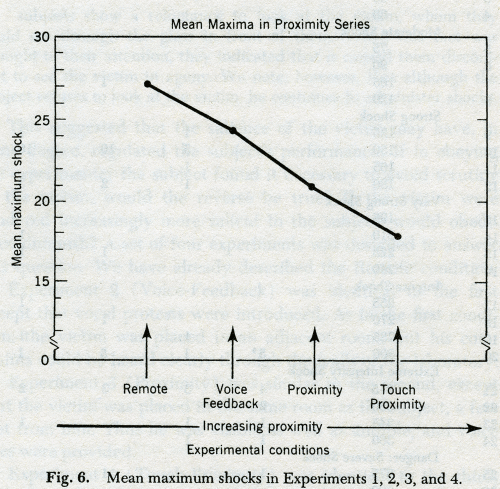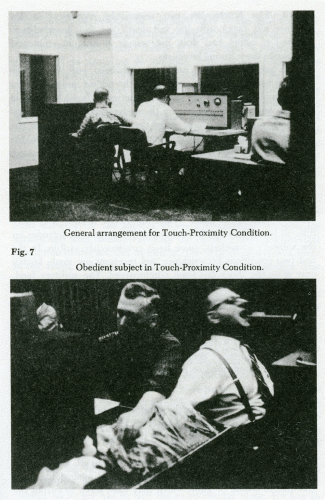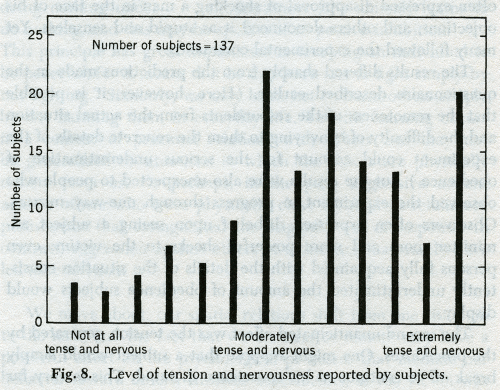
- •1. The Dilemma of Obedience
- •2. Method of Inquiry
- •Interview and Debriefing
- •3. Expected Behavior
- •4. Closeness of the Victim
- •5. Individuals Confront Authority
- •6. Further Variations and Controls
- •7. Individuals Confront Authority II
- •8. Role Permutations
- •9. Group Effects
- •10. Why Obedience? -- An Analysis
- •Variability
- •11. The Process of Obedience: Applying the Analysis to the Experiment
- •Institutional Setting
- •Immediate Antecedent Conditions
- •12. Strain and Disobedience
- •13. An Alternative Theory: Is Aggression the Key?
- •15. Epilogue
4. Closeness of the Victim
Now let us look at the actual performance of subjects in the experiment. To begin, we shall consider the results of the Remote- Feedback variation (Experiment 1). It differs slightly from the usual situation in that no vocal complaint is heard from the victim. He is placed in another room where he cannot be seen by the subject, nor can his voice be heard; his answers flash silently on the signal box. However, at 300 volts the laboratory walls resound as he pounds in protest. After 315 volts, no further answers appear, and the pounding ceases.
It is instructive to reprint the subjects’ remarks at the point of defiance, as transcribed from the tape recordings:
“I think he’s trying to communicate, he’s knocking.... Well it’s not fair to shock the guy ... these are terrific volts. I don’t think this is very humane. Oh, I can’t go on with this; no, this isn’t right. It’s a hell of an experiment. The guy is suffering in there. No, I don’t want to go on. This is crazy.” (Subject refuses to administer more shocks.)
“He’s banging in there. I’m gonna chicken out. I’d like to continue, but I can’t do that to a man. I’m sorry I can’t do that to a man. I’ll hurt his heart. You take your check.... No really, I couldn’t do it.”
Of the 40 subjects, 26 obeyed the orders of the experimenter to the end, proceeding to punish the victim until they reached the most potent shock available on the generator. After the 450-volt shock was administered three times, the experimenter called a halt to the session.
Subjects were frequently in an agitated state. Sometimes, verbal protest was at a minimum, and the subject simply got up from his chair in front of the shock generator, indicating that he wished to leave the laboratory. Some obedient subjects expressed reluctance to administer shocks beyond the 300-volt level and displayed tensions similar to those who defied the experimenter.
After the maximum shocks had been delivered, and the experimenter called a halt to the proceedings, many obedient subjects heaved sighs of relief, mopped their brews, rubbed their fingers over their eyes, or nervously fumbled cigarettes. Some shook their heads, apparently in regret. Some subjects had remained calm throughout the experiment and displayed only minimal signs of tension from beginning to end.
Bringing the Victim Closer
An experiment differs from a demonstration in that in an experiment, once an effect has been observed, it becomes possible to alter systematically the conditions under which it is produced, and in this way to learn the relevant causes.
What we have seen thus far applies only to a situation in which the victim is out of sight and unable to communicate with his own voice. The recipient of the punishment is thus remote, nor does he indicate his wishes very clearly. There is pounding on the wall, but this has an inherently ambiguous meaning; possibly, some subjects did not interpret this pounding as evidence of the victim’s distress. The resulting obedience may be attributable to this. Perhaps there will be no obedience when the victim’s suffering is more clearly communicated; when the victim is given a sense of presence, and he is seen, heard, and felt.
Behavior noted in our pilot studies lent credence to this notion. In those studies the victim could be dimly perceived by the subject through a silvered glass. Subjects frequently averted their eyes from the person they were shocking, often turning their heads in an awkward and conspicuous manner. One subject explained, “I didn’t want to see the consequences of what I had done.” Observers noted:
... subjects show a reluctance to look at the victim, whom they could see through the glass in front of them. When this fact was brought to their attention, they indicated that it caused them discomfort to see the victim in agony. We note, however, that although the subject refuses to look at the victim, he continues to administer shocks.
This suggested that the salience of the victim may have, in some degree, regulated the subject’s performance. If in obeying the experimenter the subject found it necessary to avoid scrutiny of the victim, would the reverse be true? If the victim were rendered increasingly more salient to the subject, would obedience diminish? A set of four experiments was designed to answer this question. We have already described the Remote condition.
Experiment 2 (Voice-Feedback) was identical to the first except that vocal protests were introduced. As in the first condition, the victim was placed in an adjacent room, but his complaints could be heard clearly through the walls of the laboratory.
Experiment 3 (Proximity) was similar to the second, except that the victim was placed in the same room as the subject, a few feet from him. Thus he was visible as well as audible, and voice cues were provided.
Experiment 4 (Touch-Proximity) was identical to the third, with this exception: the victim received a shock only when his hand rested on a shock plate. At the 150-volt level the victim demanded to be let free and refused to place his hand on the shock plate. The experimenter ordered the subject to force the victim’s hand onto the plate. Thus obedience in this condition required that the subject have physical contact with the victim in order to give him punishment at or beyond the 150-volt level.
Forty adult subjects were studied in each condition. The results, shown in Table 2, revealed that obedience was significantly reduced as the victim was rendered more immediate to the subject. The mean maximum shock for the conditions is shown in Figure 6.

Table 2. Maximum Shocks Administered in Experiments 1, 2, 3, and 4
Thirty-five percent of the subjects defied the experimenter in the Remote condition, 37.5 percent in Voice-Feedback, 60 percent in Proximity, and 70 percent in Touch-Proximity.

Fig. 6. Mean maximum shocks in Experiments 1, 2, 3 and 4.
How are we to account for the diminishing obedience as the victim is brought closer? Several factors may be at work.
1. Empathic cues. In the Remote and, to a lesser extent, the Voice-Feedback conditions, the victim’s suffering possesses an abstract, remote quality for the subject. He is aware, but only in a conceptual sense, that his actions cause pain to another person; the fact is apprehended but not felt. The phenomenon is common enough. The bombardier can reasonably suppose that his weapons will inflict suffering and death, yet this knowledge is divested of affect and does not arouse in him an emotional response to the suffering he causes.

Fig. 7: General arrangement for Touch-Proximity Condition; Obedience subject in Touch-Proximity Condition.
It is possible that the visual cues associated with the victim’s suffering trigger empathic responses in the subject and give him a more complete grasp of the victim’s experience. It is also possible that the empathic responses are themselves unpleasant, possessing drive properties which cause the subject to terminate the arousal situation. Diminishing obedience, then, would be explained by the enrichment of empathic cues in the successive experimental conditions.
2. Denial and narrowing of the cognitive field. The Remote condition allows a narrowing of the cognitive field so that the victim is put out of mind. When the victim is close it is more difficult to exclude him from thought. He necessarily intrudes on the subject’s awareness, since he is continuously visible. In the first two conditions his existence and reactions are made known only after the shock has been administered. The auditory feedback is sporadic and discontinuous. In the Proximity conditions his inclusion in the immediate visual field renders him a continuously salient element for the subject. The mechanism of denial can no longer be brought into play. One subject in the Remote condition said, “It’s funny how you really begin to forget that there’s a guy out there, even though you can hear him. For a long time I just concentrated on pressing the switches and reading the words.”
3. Reciprocal fields. If in the Proximity conditions, the subject is in an improved position to observe the victim, the reverse is also true: the actions of the subject now come under scrutiny by the victim. Possibly, it is easier to harm a person when he is unable to observe our actions than when he can see what we are doing. His surveillance of the action directed against him may give rise to shame or guilt, which may then serve to curtail the action. Many expressions of language refer to the discomfort or inhibitions that arise in face-to-face attack. It is often said that it is easier to criticize a man “behind his back” than to confront him directly. If we are lying to someone, it is reputedly difficult to “look him in the eye.” We “turn away in shame” or in “embarrassment,” and this action serves to reduce our discomfort. The manifest function of allowing the victim of a firing squad to be blindfolded is to make the occasion less stressful for him, but it may also serve a latent function of reducing the stress of the executioner. In short, in the Proximity conditions, the subject may sense that he has become more salient in the victim’s field of awareness and consequently becomes more self-conscious, embarrassed, and inhibited in his punishment of the victim.
4. Experienced unity of act. In the Remote conditions it is more difficult for the subject to see a connection between his actions and their consequences for the victim. There is a physical separation of the act and its effects. The subject depresses a lever in one room, and protests and cries are heard from another. The two events are in correlation, yet they lack a compelling unity. The unity is more fully achieved in the Proximity conditions as the victim is brought closer to the action that causes him pain. It is rendered complete in Touch-Proximity.
5. Incipient group-formation. Placing the victim in another room not only takes him farther from the subject, it also draws the subject and the experimenter relatively closer. There is incipient group formation between the experimenter and the subject, from which the victim is excluded. The wall between the victim and the others deprives him of an intimacy which the experimenter and the subject could feel. In the Remote condition, the victim is truly an outsider, who stands alone, physically and psychologically.
When the victim is placed close to the subject, it becomes easier to form an alliance with him against the experimenter. The subject no longer has to face the experimenter alone. He has an ally who is close at hand and eager to collaborate in a revolt against the experimenter. Thus, the changing set of spatial relations leads to a potentially shifting set of alliances over the several experimental conditions.
6. Acquired behavior dispositions. It is commonly observed that laboratory mice will rarely fight with their litter mates. Scott (1958) explains this in terms of passive inhibition. He writes: “By doing nothing under ... circumstances [the animal] learns to do nothing, and this may be spoken of as passive inhibition. This principle has great importance in teaching an individual to be peaceful, for it means that he can learn not to fight simply by not fighting.” Similarly, we may learn not to harm others simply by not harming them in everyday life. Yet this learning occurs in a context of proximal relations with others and may not be generalized to situations in which the others are physically remote from us. Or perhaps, in the past, aggressive actions against others who were physically close resulted in retaliatory punishment that extinguished the original form of response. In contrast, aggression against others at a distance may rarely have led to retaliation.
We move about; our spatial relations shift from one situation to the next, and the fact that we are near or remote may have a powerful effect on the psychological processes that mediate our behavior toward others. In these experiments, as the victim was brought closer to the man ordered to give him shocks, increasing numbers of subjects broke off the experiment, refusing to obey. The concrete, visible, and proximal presence of the victim acted in an important way to counteract the experimenter’s power and to generate disobedience. Any theoretical model of obedience will have to take this fact into account.
Unexpected Behavior
The over-all level of obedience, across all four experimental variations, requires comment. Subjects have learned from childhood that it is a fundamental breach of moral conduct to hurt another person against his will. Yet, almost half the subjects abandon this tenet in following the instructions of an authority who has no special powers to enforce his commands. To disobey would bring no material loss or punishment. It is clear from the remarks and behavior of many participants that in punishing the victim they were often acting against their own values. Subjects often expressed disapproval of shocking a man in the face of his objections, and others denounced it as stupid and senseless. Yet many followed the experimental commands.
The results differed sharply from the predictions made in the questionnaire described earlier. (Here, however, it is possible that the remoteness of the respondents from the actual situation and the difficulty of conveying to them the concrete details of the experiment could account for the serious underestimation of obedience.) But the results were also unexpected to people who observed the experiment in process through one-way mirrors. Observers often expressed disbelief upon seeing a subject administer more and more powerful shocks to the victim; even persons fully acquainted with the details of the situation consistently underestimated the amount of obedience subjects would display.
The second unanticipated effect was the tension generated by the procedures. One might suppose that a subject would simply break off or continue as his conscience dictated. This is very far from what happened. There were in some subjects striking reactions of emotional strain.
In the interview following the experiment subjects were asked to indicate on a 14-point scale just how nervous or tense they felt at the point of maximum tension (Figure 8). The scale ranged from “Not at all tense and nervous” to “Extremely tense and nervous.” Self-reports of this sort are of limited precision and at best provide only a rough indication of the subject’s emotional response. Still, taking the reports for what they are worth, it can be seen that the distribution of responses spans the entire range of the scale, with the majority of subjects concentrated at the center and upper extreme. A further breakdown showed that obedient subjects reported themselves as having been slightly more tense and nervous than the defiant subjects at the point of maximum tension.

Fig. 8. Level of tension and nervousness reported by subjects.
How is the occurrence of tension to be interpreted? First, it points to the presence of conflict. If a tendency to comply with authority were the only psychological force operating in the situation, all subjects would have continued to the end, and there would have been no tension. Tension, it is assumed, results from the simultaneous presence of two or more incompatible response tendencies (Miller, 1944). If sympathetic concern for the victim were the exclusive force, all subjects would have calmly defied the experimenter. Instead, there were both obedient and defiant outcomes, frequently accompanied by extreme tension. A conflict develops between the deeply ingrained disposition not to harm others and the equally compelling tendency to obey others who are in authority. The subject is quickly drawn into a dilemma, and the presence of high tension points to the considerable strength of each of the antagonistic vectors.
Moreover, tension defines the strength of the aversive state from which the subject is unable to escape through disobedience. When a person is uncomfortable, tense, or stressed, he tries to take some action that will allow him to terminate this unpleasant state. Thus tension may serve as a drive that leads to escape behavior. But in the present situation even where tension is extreme, many subjects are unable to perform the response that will bring about relief. Therefore there must be a competing drive, tendency, or inhibition that precludes activation of the disobedient response. The strength of this inhibiting factor must be of greater magnitude than the stress experienced, or else the terminating act would occur. Every evidence of extreme tension sat the same time an indication of the strength of the forces that keep the subject in the situation.
Finally, tension may be taken as evidence of the reality of the situation for the subject. Normal subjects do not tremble and sweat unless they are implicated in a deep and genuinely felt predicament.
